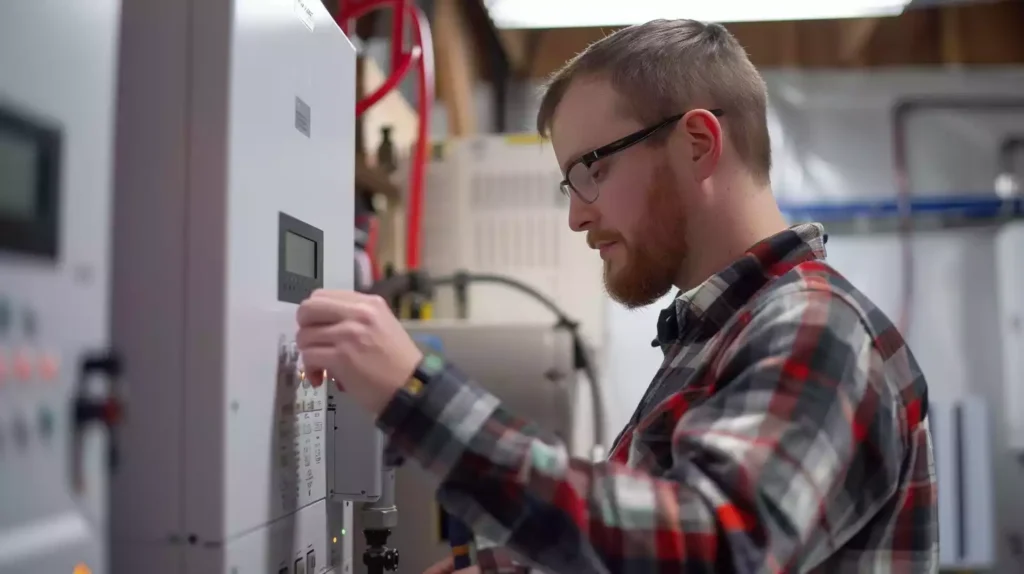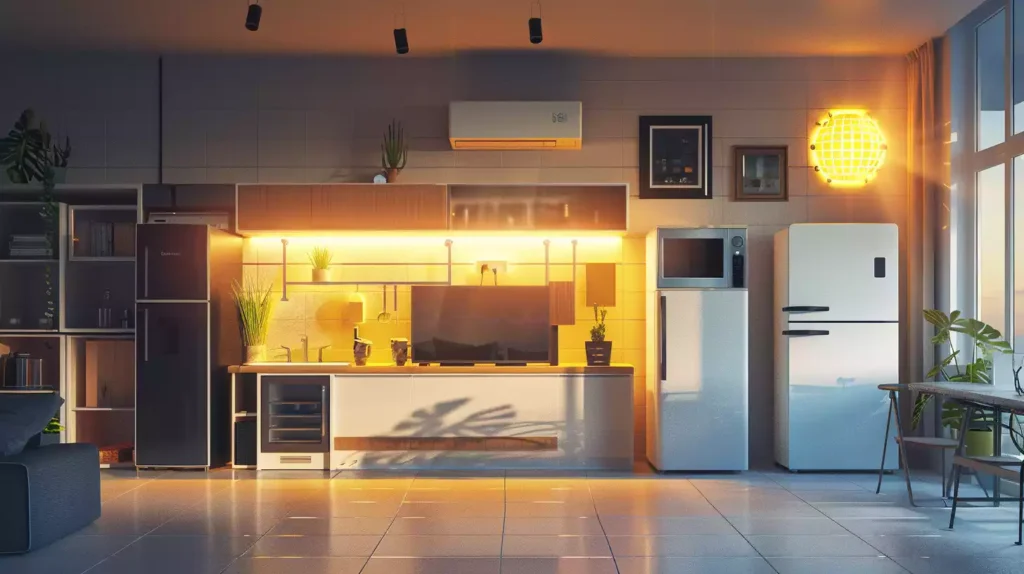How To Size an Inverter: Solar Inverter Sizing Explained
When sizing an inverter, calculate the total wattage needed and understand surge vs. continuous power. Choose the right size with a 20% safety margin.
Factor in simultaneous device use and peak power requirements and add essential margin for future power needs and system upgrades.
Follow installation tips near the battery with the correct cables, grounding, and ventilation, and select continuous output aligned with total wattage requirements.
Keep reading for more tips on how to size an inverter correctly.
Main Points Covered Below
- Calculate total wattage needed with safety margin.
- Consider surge power for peak demands.
- Select inverter size aligned with total wattage.
- Factor in future expansion for scalability.
- Ensure proper installation, grounding, and ventilation.

Assessing Power Needs
Evaluating my power needs involves calculating the total wattage required by adding up the wattages of all devices I plan to power.
When considering an inverter’s size, it’s important to understand the difference between surge power, which is the peak power needed to start a device, and continuous power, the amount required to keep it running.
These factors play a significant role in determining the right inverter size for my setup.
To accurately size the inverter, I must calculate the total wattage needed, factoring in both running watts and surge requirements of the devices. Adding a safety margin of 20% ensures that the inverter can handle unexpected power spikes without overloading.
Estimating simultaneous device usage helps in determining the appropriate size to support multiple devices running concurrently. By taking these aspects into account, I can confidently select the right inverter size that meets my power needs efficiently.
Calculating Total Wattage
To accurately determine the total wattage needed for an inverter setup, add up the running watts of all devices you plan to power.
It’s important to calculate both the running watts, which represent the continuous power consumption of the devices, and the surge watts, which indicate the peak power requirements for appliances with electric motors.
By summing up these values, you can find the total wattage needed for your inverter. Remember to include a safety margin of 10-20% when calculating the total wattage to guarantee your inverter can handle unexpected power spikes without overloading.
Understanding the total wattage required is vital for selecting the right size inverter that can meet your power demands efficiently. Taking into account the specific power needs of each device and factoring in the safety margin will guide you in choosing an inverter that can reliably power your appliances.
Adding Safety Margin
Considering the importance of safeguarding against unexpected power fluctuations, incorporating a 10-20% safety margin when calculating total device wattages for an inverter setup is vital.
When determining the inverter size, adding this additional wattage guarantees that your power requirements are met without pushing the inverter to its limits.
Here are some reasons why including this buffer is very important:
- Prevents Underperformance: The safety margin guards against potential dips in power output, ensuring consistent performance.
- Accommodates Power Demand Increases: As your power needs grow, the extra capacity allows for the seamless integration of additional devices.
- Enhances Flexibility: Opting for a larger inverter than the minimum required size provides room for system expansion without strain.
- Avoids Overloading: By selecting the right inverter power with a safety margin, you prevent overtaxing the system and potential breakdowns.
Selecting Continuous Output
To guarantee a reliable power supply, it is essential to align the continuous output of the inverter with or surpass the total wattage requirements of all connected devices. When selecting the continuous power for your inverter, it’s important to take into account the power needs of all the devices you plan to run simultaneously.
By summing up the wattage requirements of these devices, you can determine the inverter size you need to guarantee uninterrupted power supply without overloading the system.
Consider the following table for a clearer understanding of how to select the appropriate continuous output for your inverter:
| Device | Wattage Requirement | Total Wattage |
|---|---|---|
| Device 1 | 500W | |
| Device 2 | 300W | |
| Device 3 | 700W | |
| Total Power Needs | 1500W |
Selecting an inverter with a continuous output rating that meets or exceeds the total wattage of all connected devices is crucial to guarantee efficient operation and prevent underperformance.
By accurately sizing your inverter’s continuous output, you can ensure a smooth power supply for all your power devices.
Considering Future Expansions
When planning for future expansions, it’s vital to think ahead and anticipate the need for increased power capacity. Selecting an inverter that can easily accommodate additional loads guarantees scalability without overwhelming the system.
Ensuring adaptability in your setup allows for seamless integration of new components as your power requirements evolve.

Future Growth Planning
As I plan for future expansions, I must anticipate additional appliances and power needs when sizing an inverter.
- Verify the inverter can handle any upgrades or additions to your electrical system.
- Choose a scalable inverter to accommodate increased power requirements.
- Factor in potential additions of more devices or appliances.
- Select an inverter with the capacity to support the growth and expansion of your electrical setup.
Upgrading Capacity Options
Considering future expansions in power needs, upgrading inverter capacity is essential to guarantee flexibility and accommodate growing demands. Anticipating the need for additional power due to new appliances or increased energy consumption is vital when determining the right size inverter for your DC system.
By choosing a larger inverter size with a higher continuous rating, you can make certain that your system has the capacity to support future expansions without the need for frequent upgrades. This proactive approach also extends to your battery bank capacity, aligning all components for peak performance.
Planning for future growth in energy consumption now will save you time and resources in the long run, ensuring that your power system remains efficient and effective as your needs evolve.
| Inverter Size | Suitability |
|---|---|
| Larger | Accommodates future expansions effectively. |
| Right Size | Meets current needs without excess capacity. |
| Oversized | Provides room for growth and prevents frequent upgrades. |
| Small | May lead to system strain or limitations in the future. |
Ensuring Optimal Performance
To guarantee peak performance when sizing an inverter, always compute the total wattage needed for all appliances to be powered.
This guarantees that the inverter can adequately supply power to all devices without overloading. Here are some key points to take into account for ensuring top performance:
- Calculate the total wattage by adding up the running watts of all appliances.
- Take into consideration the surge requirements of appliances with electric motors.
- Choose an inverter size that’s at least 20% larger than the total calculated wattage.
- Identify the largest power draws in your RV to accurately size the inverter for your specific needs.
Installation and Wiring Considerations
Proper placement of the inverter near the battery source is important for efficient power transfer during installation. Ensuring the correct gauge cables are used is essential for best power transmission and preventing energy loss.
It’s crucial to follow safety guidelines for proper grounding to avoid electrical hazards. Adequate ventilation plays a significant role in maintaining the inverter’s performance by allowing proper airflow for cooling.
Regular maintenance checks on connections and cleaning the inverter are necessary for best functionality and longevity.
| Consideration | Importance | Details |
|---|---|---|
| Inverter Size | High | Match to power supply needs |
| Battery System | Medium | Compatible with inverter capacity |
| DC to AC Conversion | High | Efficient power transformation |
| Proper Installation | High | Near battery for efficient transfer |
| Power Transmission | High | Ensure correct gauge cables |
Grounding and Ventilation Tips
Grounding your inverter is vital for safety and device protection, while proper ventilation is essential to prevent overheating and extend its lifespan. Following manufacturer guidelines for grounding is necessary to maintain warranties and avoid electrical hazards.
Remember to guarantee adequate airflow around the inverter and regularly clean it to keep ventilation unobstructed and performance at its best.
Grounding Safety Tips
Ensuring the inverter is both grounded and well-ventilated is vital for maintaining safety and performance.
- Proper grounding prevents electrical shocks and guarantees safe operation.
- Grounding reduces the risk of electrical fires and protects devices.
- Adequate ventilation prevents overheating, enhancing efficiency.
- Good ventilation dissipates heat, extending the inverter’s lifespan.
These steps are essential for inverter safety and performance, safeguarding against hazards like electrical fires.
By following grounding and ventilation guidelines, we create a secure environment for the inverter to function at its best.
Ventilation Requirements for Inverter
To guarantee peak performance and prevent overheating, it’s essential to place inverters in well-ventilated areas.
Proper ventilation is critical for dissipating the heat generated during operation, ensuring the inverter’s efficiency and longevity. Adequate airflow around the inverter is necessary to maintain ideal functioning.
Grounding the inverter according to manufacturer guidelines is essential for safety and proper functionality. Following these ventilation and grounding recommendations not only prevents electrical hazards but also guarantees reliable inverter operation.
Proper Grounding and Ventilation
Maximizing the efficiency and safety of your inverter requires proper grounding and ventilation practices.
To guarantee your inverter operates smoothly and safely, consider the following tips:
- Grounding: Proper grounding is essential to prevent electrical shocks and ensure safety. Follow manufacturer guidelines for grounding requirements based on your inverter size and installation location.
- Ventilation: Adequate ventilation is vital to dissipate heat and prevent overheating, which can lead to potential damage. Good ventilation practices help maintain efficient operation and prolong the lifespan of your inverter.
Maintenance for Efficiency
Regularly cleaning the inverter’s cooling fans and vents is essential to prevent overheating and maintain peak efficiency. Ensuring proper ventilation helps the inverter size operate efficiently by preventing heat buildup.
Checking and tightening all electrical connections in the battery system is critical for maintaining a stable power flow and preventing energy loss. Monitoring the battery health and charge levels is also key to ensuring the inverter operates at peak performance.
Keep an eye on the inverter’s display for any error codes or alerts that may signal maintenance needs for efficient operation. Adhering to the manufacturer’s recommended maintenance schedules is crucial for prolonging the lifespan and efficiency of the inverter.
Inverter Flexibility and Performance
Inverters provide versatile power options for RVs, boats, and off-grid setups, offering flexibility to accommodate various devices and appliances. When it comes to inverter flexibility and performance, matching the inverter size to your power needs is important for best efficiency and the longevity of your battery system.
Customizing your inverter setup allows you to power specific appliances or circuits as needed, making sure that you have the right balance of AC power converted from DC power. This customization not only enhances efficiency but also prevents overloading your electrical system, in the end leading to reliable operation of your electronic devices.
Selecting the right inverter size is like finding the perfect puzzle piece – it ensures everything runs smoothly and efficiently in your power setup.
